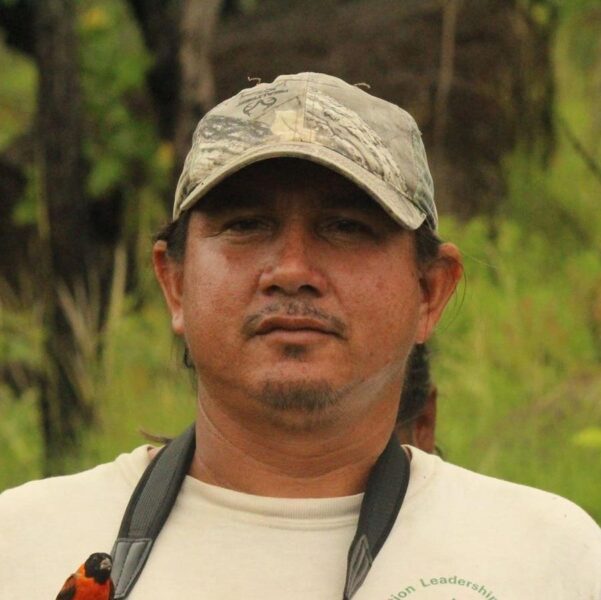Leroy Ignacio holding a male Red Siskin in the South Rupununi in 2017.
Chung Liu
Indigenous conservationists are helping to save the Red Siskin (Spinus cucullatusa) — an endangered little red bird — after it was “discovered” there in 2000.
Although Guyana is one of the world’s fastest growing economies, it is a heavily forested, biodiverse country and only about 9 percent of its territory is slated for conservation.
Leroy Ignacio, president of the South Rupununi Conservation Society, a grassroots Indigenous-led conservation NGO, explains that in 2000, he was guiding scientists from the Smithsonian Institute and the University of Kansas when they spotted a Red Siskin, a bird already slated as endangered in Venezuela and Colombia.
“The Red Siskin was then considered ‘scientifically discovered’ in Guyana,” he says, adding that it is important to note that local residents knew of the species and even had a local name for the bird, they just weren’t aware of its conservation status.
“The discovery of the siskin then acted as a catalyst for myself and a group of friends from other surrounding communities to form the SRCS to help protect the siskin and other important species,” he says, adding that the NGO has now created a 75,000 hectare Red Siskin Community Managed Conservation Zone and they now have over 200 active registered members, including people from the region’s Indigenous peoples like the Wapichan, Makushi and Wai Wai.
“My colleagues and I have worked to collect information on the species locally as there was no knowledge on the Red Siskin prior to 2000,” Ignacio says, “This includes determining the range of the siskin, conducting population estimates through mist netting and banding, completing genetic analysis through blood sampling, assessing their life cycle and observing their behavior.”
Ignacio explains they have also rolled out an environmental education curriculum; publishing of a local bird guide and taking Indigenous youth on bird watching expeditions — all with the aim of lowering habitat destruction and trapping.
On May 1, 2024, Her Royal Highness Princess Anne presented a £50,000 (about $62,500) Whitley Award from UK charity the Whitley Fund for Nature to Ignacio for strengthening the protection of the Red Siskin.
Growing up in Guyana
Ignacio was born and raised mainly by his grandparents in an Indigenous Macushi village called “Shulinab Village” in Guyana’s South Rupununi region, bordering the Brazilian Amazon.
“I spent my childhood in nature, at the farm and in the forest during which time my grandfather passed down his traditional knowledge and taught me the importance of preserving our resources and wildlife,” he says, adding that when he was 12, he received a scholarship and spent 5 years Guyana’s capital.
“When I returned to the Rupununi, I noticed big changes including more infrastructural development, greater exploitation of natural resources (including minerals and wildlife) and a loss of culture,” Ignacio says, “This inspired me to want to do something to prevent further losses occurring.”
Ignacio explains that much of the world’s biodiversity can be found in the Global South, but researchers there are often viewed as lacking the scientific capacity for research and conservation.
“The world is now recognizing that Indigenous people have sustainably managed their biodiversity for years and that even now, many areas under the stewardship and management of Indigenous people have higher levels of biodiversity than protected areas, national parks etc,” he says, adding that the Rupununi region has been a victim of “parachute science” where foreign scientists and international NGOs conduct studies and research, then leave without sharing the results, leaving equipment or building capacity.
“This trend is changing and many NGOs and scientists are recognizing the importance of building local capacity,” Ignacio says, “Further, it is important to recognize that Indigenous People possess local and traditional knowledge which is essential for successful conservation yet we recognize that we also need scientific knowledge to manage our wildlife and this is where we need support in building our capacity.”
A male Red Siskin in the South Rupununi in 2017.
Chung Lui
Citizen Science in Colombia
Elsewhere in northern South America, Colombian biologists have leveraged hundreds of observations made by non-scientists to build up a picture of hummingbirds’ range in time and space.
Cristina Rueda-Uribe, a PhD candidate at the University of Aberdeen, Scotland, explains that she focuses on hummingbirds in the high-mountain ecosystems of elfin forest and alpine meadow (paramo) in the northern Andes mountain range.
In a research article called Citizen science data reveal altitudinal movement and seasonal ecosystem use by hummingbirds in the Andes Mountains and published in the journal Ecography, Rueda-Uribe and her coauthors inferred movement of Andean hummingbirds by calculating changes in their range (including altitude) and their ecosystems, thanks to “citizen science” data.
Rueda-Uribe explains that “citizen science” data is generated by people that publish in public databases their records of species that they see or hear, which helps scientists and also allows non-scientists to get more involved with nature.
“The power of these data lies in the fact that their use is getting more and more popular, so millions of data points are readily available over large spatial scales and encompassing different time periods,” she says, “This is much more than scientists could collect, even with the largest research budgets and all the time in the world.”
Source link : http://www.bing.com/news/apiclick.aspx?ref=FexRss&aid=&tid=673eca1a64504e71843d8d14c2ae37d9&url=https%3A%2F%2Fwww.forbes.com%2Fsites%2Fandrewwight%2F2024%2F05%2F23%2Fhow-are-indigenous-groups-in-guyana-saving-the-bird-they-discovered%2F&c=12798929998678527239&mkt=en-us
Author :
Publish date : 2024-05-23 05:26:00
Copyright for syndicated content belongs to the linked Source.
